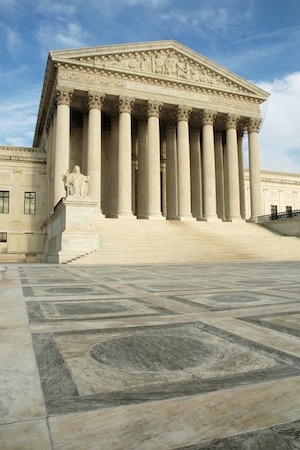Pactiv, LLC v. Lee presents a question fundamental to all ex parte reexaminations: whether, after the PTO initiates an ex parte reexamination, that proceeding is limited in scope to the question determined to qualify as the “substantial new question of patentability.”
 An inventor obtains a patent by applying to the U.S. Patent & Trademark Office (PTO). During patent prosecution, a patent examiner considers whether, among other things, the inventor’s claims are patentable in light of the relevant prior art.
An inventor obtains a patent by applying to the U.S. Patent & Trademark Office (PTO). During patent prosecution, a patent examiner considers whether, among other things, the inventor’s claims are patentable in light of the relevant prior art.
On some occasions, the patent examiner may not be aware of relevant prior art, or the patent examiner may not understand how certain prior art relates to the claimed invention. As a result, Congress has created mechanisms by which the PTO may later review issued patent claims. Relevant here, any party (including the PTO Director) may submit prior art references and request the PTO to institute an ex parte reexamination of issued patent claims.
Cognizant that an unbridled review system could impose enormous burden and undue harassment on patentees, Congress crafted a threshold safeguard to protect patentees against complete review of patents against their will. The PTO may initiate an ex parte reexamination only if it first determines that the request raises a “substantial new question of patentability.” 35 U.S.C. § 303(a). That is a demanding standard: it requires a showing of a new question not previously considered by the Patent Office.
If the Director finds that there is a “substantial new question of patentability,” then the Director must issue an order for “reexamination of the patent for resolution of the question.” 35 U.S.C. § 304 (emphasis added). Ex parte reexaminations are not, therefore, complete patentability reviews.
An ex parte reexamination thus differs materially from a reissue proceeding. That form of post-grant review is a complete patentability review. But the threshold for institution is far higher than an ex parte reexamination—a reissue proceeding begins only if the patent holder agrees to surrender the patent.
Pactiv, LLC v. Lee presents a question fundamental to all ex parte reexaminations: whether, after the PTO initiates an ex parte reexamination, that proceeding is limited in scope to the question determined to qualify as the “substantial new question of patentability.”
[Supreme-Court]
Here, the PTO Director initiated ex parte reexaminations of two patents owned by Pactiv LLC, a subsidiary of Reynolds Group Holdings. The patents relate to novel means of packaging meat to keep it from turning brown.
The “substantial new question of patentability” identified by the Director included certain prior art references. But the examiner subsequently rejected several of Pactiv’s claims due to wholly different prior art references. There was never any determination under 35 U.S.C. § 303 that these other references raised a “substantial new question of patentability,” nor did the Director issue the order required under Section 304 identifying a “substantial new question of patentability” based on these wholly different prior art references. The patent examiner, Patent Trial and Appeal Board, and the Federal Circuit all rejected petitioner’s argument that the examiner’s final office action exceeded the proper scope of ex parte reexamination.
The petition for certiorari I recently filed on behalf of Pactiv contends that the Supreme Court’s review is warranted for three reasons.
First, this question is quite significant, as its answer will determine the framework for the several hundred ex parte reexaminations conducted annually. The approach taken by the PTO—and affirmed below—guts important safeguards Congress has imposed to protect patentees from undue burden.
Second, the Federal Circuit has deviated from the plain language of the Patent Act. When the PTO Director “finds that a substantial new question of patentability affecting any claim of a patent is raised,” the Director shall then issue an order “for reexamination of the patent for resolution of the question.” 35 U.S.C. § 304 (emphasis added). The statute is unambiguous: the scope of an ex parte reexamination is limited to those issues identified in the Director’s order as raising a “substantial new question of patentability.”
Third, the Federal Circuit’s summary affirmance in this case heightens the need for review. In recent years, the Federal Circuit has resolved a significant portion of its docket via use of its Circuit Rule 36, which provides for summary affirmance. The Federal Circuit may not avoid scrutiny of thorny questions of statutory interpretation through persistent use of its Circuit Rule 36.

![[IPWatchdog Logo]](https://ipwatchdog.com/wp-content/themes/IPWatchdog%20-%202023/assets/images/temp/logo-small@2x.png)

![[Advertisement]](https://ipwatchdog.com/wp-content/uploads/2024/04/UnitedLex-May-2-2024-sidebar-700x500-1.jpg)
![[Advertisement]](https://ipwatchdog.com/wp-content/uploads/2024/04/Artificial-Intelligence-2024-REPLAY-sidebar-700x500-corrected.jpg)
![[Advertisement]](https://ipwatchdog.com/wp-content/uploads/2024/04/Patent-Litigation-Masters-2024-sidebar-700x500-1.jpg)

![[Advertisement]](https://ipwatchdog.com/wp-content/uploads/2021/12/WEBINAR-336-x-280-px.png)
![[Advertisement]](https://ipwatchdog.com/wp-content/uploads/2021/12/2021-Patent-Practice-on-Demand-recorded-Feb-2021-336-x-280.jpg)
![[Advertisement]](https://ipwatchdog.com/wp-content/uploads/2021/12/Ad-4-The-Invent-Patent-System™.png)






Join the Discussion
6 comments so far.
Night Writer
August 24, 2016 05:57 amThey won’t take it. The issue that you so artfully walked around is that the “substantial new question of patentability” can be based on the claim elements and combination of the claim elements and doesn’t necessarily have to be tied to prior art. So, the substantial new question standard is met and which prior art references are used can be more flexible.
So, it isn’t going to be taken. Besides, the justices are strongly anti-patent and they don’t care. Alice is probably sufficient evidence to impeach each of the justices for high treason.
Anon
August 21, 2016 08:52 amThe property law aspect is actually front and center when tied to this topic of patent law vis a vis the Constitutionality of the Legislature creating a law that engages in a taking of property.
This should not be something new just now being learned.
Benny
August 21, 2016 08:13 amAnon,
Thank you for the pointer to property law. Not a day goes by that we don’t learn something new.
Anon
August 21, 2016 08:03 amBenny,
Your take notwithstanding, their is a critical difference regarding the government agency actions against a vested property.
It simply is not nearly as simple as the Executive branch contemplating for themselves that they may have “made a mistake,” and thus remove aspects of a granted property right (this is the theme under property law called “sticks in the bundle” of property rights).
No one does not understand the “why” that the patent office is using to drag the patent back into the Office against the will of the property owner – that is the “Ends” of the situation.
Rather, the critical legal point here is that these Ends – no matter how “good” they may seem – cannot violate other protections of our legal system by employing just any Means.
This very much is a critical US law aspect – and I am not sure that you are grasping that aspect.
Benny
August 21, 2016 01:41 amAnon,
Here is my take on ” what it means for that property to be dragged back into the patent office against the will of the property owner for ANY “redo.””
It means recognition that a government agency is not infallible, and that the agency may on occasion confer exclusive rights when they are undeserved, and that this has consequences for other players in the field, and that if a government agency makes a mistake in your favour that mistake might be rectified for the benefit of the public.
Anon
August 18, 2016 01:51 pmI will disagree with your characterization of the reexam standard as “demanding” or “far higher.”
It is simply more accurate to say that the standard is different. This is because that standard may actually be either far easier or more difficult depending on the facts involved.
Finding art not considered (and that means merely not considered on the record) is extremely easy to do.
Notwithstanding the tendency to try to “bloat” what is on the record with “dump-truck” levels of IDS items, the result of such decisions such as KSR opens wide the door to art that no sane person would have at the time of filing considered.
Much like the change of offering Patent Term Adjustment to “compensate” for early publishing, these types of changes were “sold” to the American public as “good things for patentees” when what had really happened is that patentees have been sold a “bill of goods” (or beach front property in Nebraska, or the Brooklyn Bridge).
A different concept – not touched by the author is the concept of a granted patent being personal property and what it means for that property to be dragged back into the patent office against the will of the property owner for ANY “redo.”